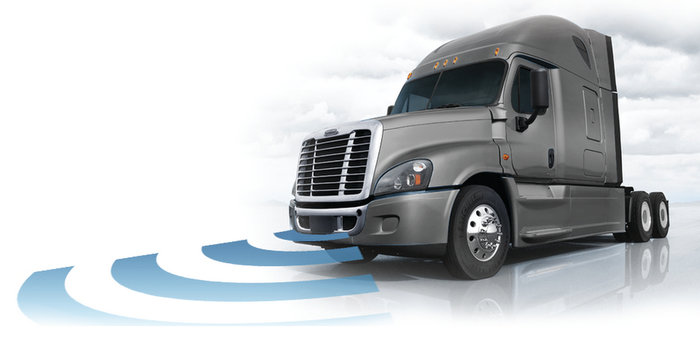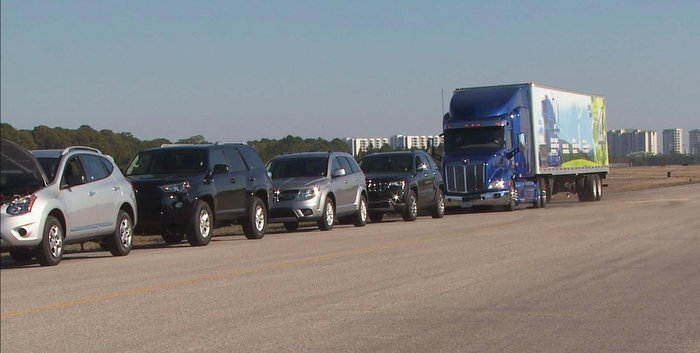In the past year, safety systems that orchestrate radar, camera systems and adaptive cruise control features have grown in popularity as fleets aim to mitigate collisions, reduce costs and better protect not only the driver and truck, but those who share the road with these heavy trucks. Let’s do a walk around of the latest advanced safety system offerings.
Bendix Wingman Fusion
Wingman Fusion combines a suite of Bendix advanced safety technologies—radar, camera, the vehicle’s brakes and Bendix SafetyDirect—into a comprehensive driver assistance system. With multiple sensors sharing and confirming situational data, the new Bendix system makes possible stationary vehicle braking, as well as overspeed alert and action—all exclusive features.
Bendix Wingman Fusion integrates technology from Bendix components and systems, including the Bendix Electronic Stability Program (ESP) full-stability system, Bendix Wingman Advanced collision mitigation technology, and Bendix’s AutoVue Lane Departure Warning System. Built on these existing technologies, Wingman Fusion gathers input through radar, video and the vehicle’s brakes, creating a data picture that’s achievable through its multi-system integration that informs the system’s operation.
Wingman Fusion’s stationary vehicle braking capability is made possible by the use of combining both radar and camera data to confirm a vehicle ahead and is activated at speeds above 15 MPH. When the system definitively recognizes a large, stationary, metallic, in-lane object as a vehicle, it notifies the driver up to three and a half seconds before a potential impact. If the driver takes no action to avoid or mitigate this potentially severe impact, the system can automatically engage the brakes to assist in lessening the severity of, or possibly avoiding, a potential collision altogether. If the system does not definitively recognize the stationary object as a vehicle, it will alert the driver up to three seconds ahead of a potential impact, with no automatic braking.
Wingman Fusion’s overspeed alert and action can be activated at 37 MPH or above and uses the system’s camera to read roadside speed limit signs, working in tandem with Bendix ESP to alert the driver when the vehicle is traveling a specified amount over the posted limit.
In terms of fleet adoption hurdles, Fred Andersky, Bendix’s director of customer solutions—controls group, pointed to fleets understanding the value of the system and ensuring that the they get a reasonable return on investment in about an 18 to 24 month time period.
“Fleets that try the systems typically tell us they find a positive ROI. For example, one of our major fleets shared with us their ability to realize a significant reduction—more than 50%—in rear-end collisions, along with a significant reduction in the severity of the remaining crashes, by adopting the Bendix Wingman Advanced collision mitigation system,” he said. “Because the fleet is self-insured, these savings go right to their bottom line.”
Key metrics to keep an eye on to determine your fleet’s ROI on safety systems, according to Andersky, would tie to the reduction in crashes and crash severity, and a reduction in the resulting costs tied to them; also keep an eye on the potential for lower insurance costs, improved CSA scores and less downtime.

Detroit Assurance
Detroit Assurance includes a base radar system that features collision mitigation as well as adaptive cruise control. It uses active braking assist (ABA) that is always on and applies the brakes to mitigate collisions, while adaptive cruise maintains a safe following distance.
The always-on ABA radar system detects objects, calculates speed and determines if a warning or action is necessary. Based on the position and speed of the truck and other vehicles, ABA warns the driver and decelerates automatically to lessen the severity of collisions that might otherwise be unavoidable.
It’s a three-step process. Step one is an audible alert that mutes the radio and activates a buzzer while also providing a visual alert on the dash. If the driver fails to react, the ABA system will partially brake to physically warn the driver to respond. In the final step, if the driver does not respond, the ABA will take command using the transmission, engine brake and service brake to slow the truck safely. (On manual transmission trucks, only the service brakes are used to slow the truck).














